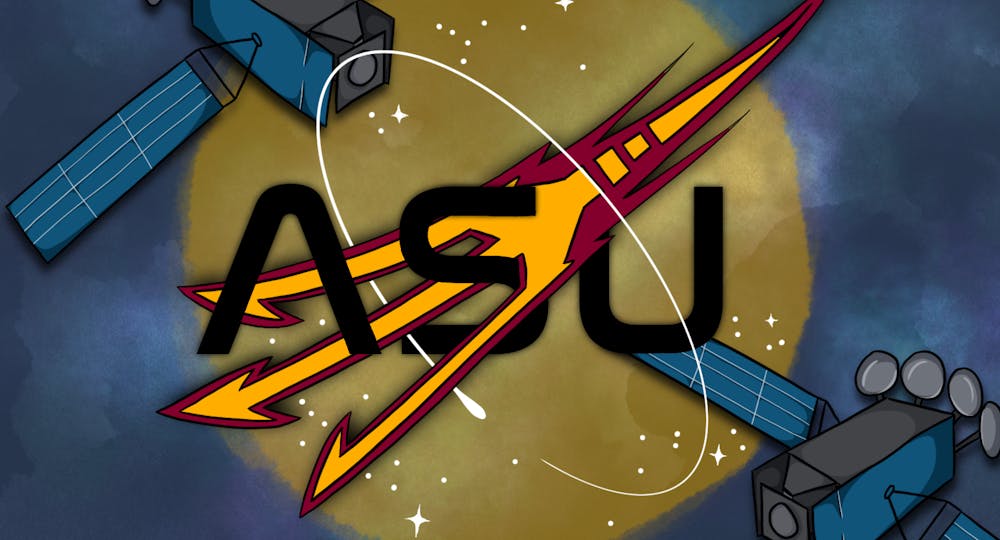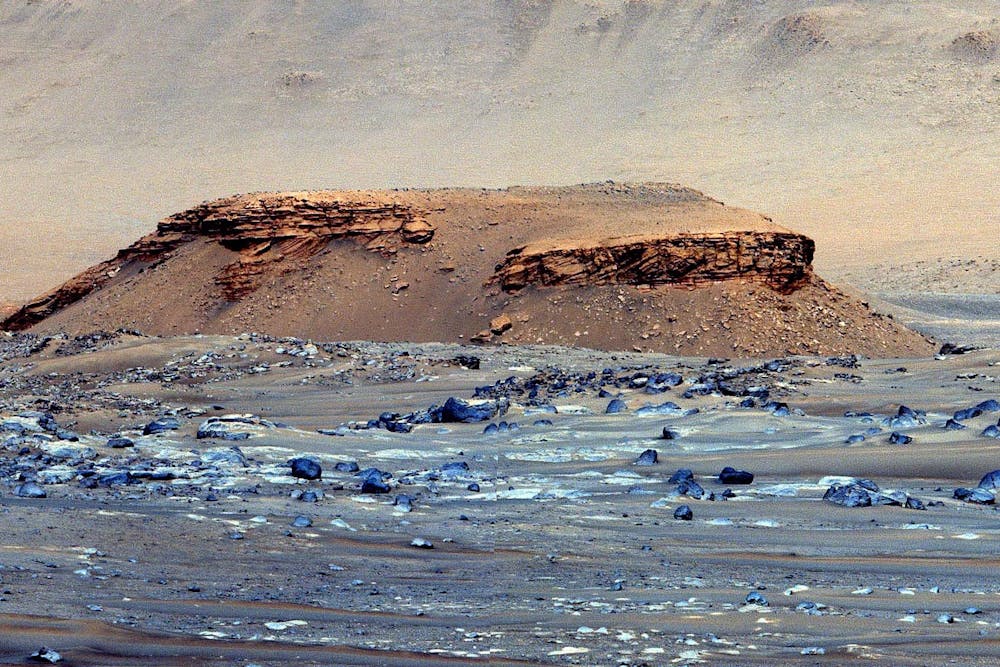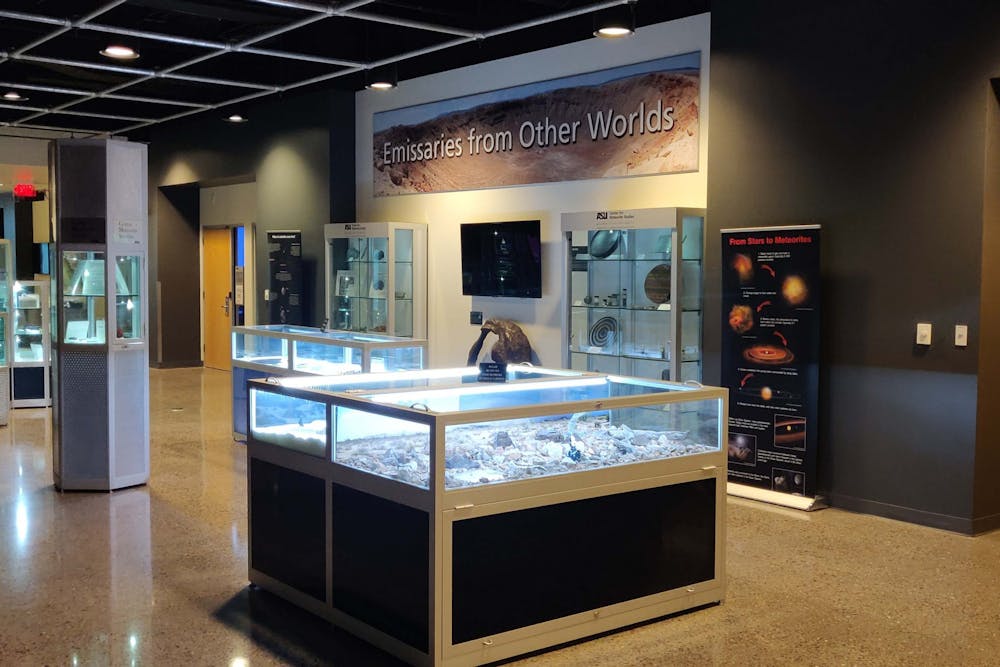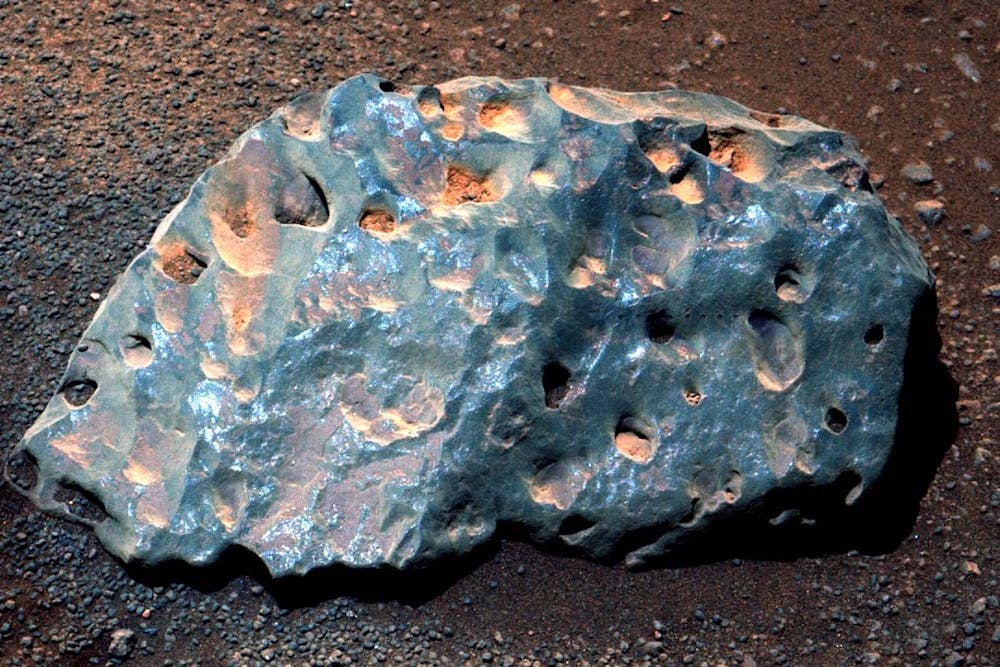Every day, ASU researchers and students explore different fields of expertise: health care, journalism and robotics. But for decades, the University has spent resources exploring space with NASA.
The University is one of the only schools in the country certified by the National Aeronautics and Space Administration to build spaceflight hardware. It has made equipment for 10 active NASA missions and is making equipment for nine more. ASU is leading two NASA missions exploring the moon's south pole and a massive asteroid.
NASA has invested hundreds of millions of dollars into ASU's space partners, and the University is home to many researchers and scientists from the agency. Since the beginning of its work with NASA, ASU has launched a space education program and constructed the largest research facility on campus for its projects.
"As we continue to prove our ability to be successful, (NASA) realized we are a solid investment, and we have protected their investment from our ability to meet the expectation," said Christopher Skiba, a research specialist who has worked at ASU for 38 years. "That's pretty hard, because, knock on wood, we've met every mission requirement, every mission schedule."
The University's deep ties with NASA are still growing, but some people sense the public does not notice. Ernest Cisneros, an associate research professional who works on MastCam-Z, said people are frequently surprised about ASU's intimate relationship with NASA.
"We have a fairly long history of supporting instruments and doing science analysis and generating data from it, but it's apparently a well-kept secret," Cisneros said. "It certainly brings a smile to my face when people are like, 'Well that's real cool, we didn't know ASU did this stuff.'"
Starting at rock bottom
NASA is an independent government agency founded in 1958 to study and explore the universe while developing technologies to achieve that goal.
Its missions have been the subject of Hollywood films and Lego sets, and its logo, a blue circle dotted in white specs with a large, diagonal, red "V" is a popular design for t-shirts.
To achieve its galactic ventures, NASA built connections with universities around the world. While NASA spent its first decade sending spacecraft out of our atmosphere, ASU was more interested in what was entering it.
Two years after NASA was founded, the University purchased part of a meteorite collection.
Carleton Moore, founder and director of the Center for Meteorite Studies established in 1961, was responsible for managing the collection of extraterrestrial rocks. He secured a NASA grant to help the center loan its collection to researchers.
The team took its expertise and applied it to moon rocks when it joined the Lunar Sample Preliminary Examination Team (LSPET).
LSPET analyzed lunar samples from the Apollo 11 mission, the first mission to get humans on the moon, deepening ASU's ties to NASA. Moore flew to Houston to collect the samples and brought them back to ASU for analysis.
As Moore's team grew, he hired people in NASA's orbit, bringing more brainpower to the University.
New hires
In 1977, Moore hired Ronald Greeley, a research scientist at NASA's Ames Research Center, who was involved in nearly every space probe mission since Apollo 11.
Greeley came to ASU and got the University involved in planetary science, according to David Williams, one of Greeley's former graduate students, director of the Ronald Greeley Center for Planetary Studies and co-investigator on NASA's Psyche Mission.
"When he came to ASU, he had all this money to work on these NASA planetary missions, and he decided to establish one of these RPIFs, these regional planetary image facilities, here at ASU," Williams said.
RPIF was a network of NASA-funded data centers for archiving planetary images. The RPIF center at ASU, now the Ronald Greeley Center for Planetary Studies, is still a partially NASA-funded project.
Greeley hired Philip Christensen, now Regents' professor and director of multiple instruments designed for NASA missions, who was a fresh graduate student when he came to the University in 1981. Instruments he and other ASU researchers built were among the first of many instruments commissioned by NASA to be built by ASU members.
At the turn of the century, ASU had the brains to construct equipment for NASA missions, but building the instruments was done off campus. That would change when the School of Earth and Space Exploration (SESE) brought scientific minds at the University together in 2006.
SESE and the ISTB4 building
SESE was founded by Kip Hodges, who served on the Planetary Science Subcommittee of the NASA Advisory Council, in collaboration with ASU President Michael Crow. The school has seven undergraduate degrees and many of its graduates work on NASA missions.
The Interdisciplinary Science and Technology Building 4 in Tempe was constructed with the intent to create equipment for NASA's spacecraft and satellites and for the public to catch a peek at the work being done in the building.
Construction started in 2008 and ISTB 4 opened its doors in 2012. The building allows for multiple types of research, many of which require their own exhaust systems.
“All the air that goes in is all exhausted, so I tell people we’ve cooled Tempe down by one degree,” Skiba said jokingly.
The seven-story giant is the largest research facility on campus, measuring around 300,000 square feet. ISTB 4 houses classrooms, labs, a planetary theater and the meteorite collection. From the building's main lobby, visitors can see the work of researchers in real-time as they analyze images from Mars rovers and build equipment for NASA missions in the cleanroom.
The cleanroom, spaces kept free of contaminants through air filtration, is where graduate students and researchers work on equipment designed for NASA missions.
"The fact that we can build world-class, incredibly complex instruments on the ASU campus, to me, is something to be extremely proud of," Christensen said.
Behind the visitor's desk are giant digital clocks showing all of SESE's space missions. Some, like the highly anticipated mission to Psyche, are counting down to the launch date, while others, like the equipment on NASA's Mars Odyssey Orbiter, show the longevity of ASU's commitment to space exploration.
Skiba, the ASU research specialist, still remembers watching the launch of the Mars Odyssey Orbiter at Cape Canaveral in 2001 that carried the Thermal Emissions Imaging System designed by Christensen's research group.
"Off to my left, up and away, was the rocket ship all highlighted, and you could see it," Skiba said. "I mean, it gives you goosebumps when you think about it."
Space exploration equipment
In one of the most recent collaborations between NASA and the University that put an ASU instrument in flight, Christensen's research group built a spacecraft device to study asteroids moving in Jupiter's orbit. The device, L'TES, is a thermal emissions spectrometer onboard NASA's Lucy.
As Lucy travels by the asteroids, it will use L'TES to determine the temperature and makeup of the asteroids using infrared technology, said Aditya Khuller, a graduate student in geological sciences.
"Instead of looking at rocks in the wavelengths or the energy our eyes see, where we see different colors, (L'TES) sees things in heat, or thermal infrared, where rocks actually glow in all kinds of colors," Khuller said.
Khuller worked on L'TES over the summer and got involved in building high-tech equipment after meeting Christensen, who taught one of his classes. The opportunity to take introductory classes taught by leading researchers is unique to SESE, Khuller said.
Khuller went to Cape Canaveral in Florida with other students and Christensen to watch the Lucy launch in October.
"It never gets old. There's something about seeing a 20-story building just sort of lift off the ground," said Christensen. "And then you start thinking of all the things (that) have to go right and so you're holding your breath. It's very emotional.”
Luckily for everyone involved in designing Lucy and L'TES, the launch was successful, and the spacecraft is embarking on a 12-year primary mission using Earth's gravity to slingshot itself toward the Trojan Asteroids and then Jupiter, where it will arrive in 2027.
Jim Bell, distinguished visiting scientist at NASA's Jet Propulsion Laboratory and seasoned professor at SESE, is the principal director of MastCam-Z, a camera on NASA's Perseverance Rover that takes photos of the Martian surface.
Alyssa Bailey, a MastCam-Z data archivist with a bachelor's degree in geological science from ASU, reviews images sent from the camera and prepares them to be viewed by the public in the Planetary Data System.
MastCam-Z takes high-quality panoramic photos of the Red Planet, and the images come in large data packets the team has to stitch together, Skiba said.
"There have been so many incredible moments, so many major milestones, and such gorgeous images that I have been a part of," Bailey said in an email.
ASU is forging an even deeper connection with NASA through CubeSats, small satellites weighing under 100 pounds.
In 2016, NASA funded ASU's first CubeSat through the ASU/NASA Space Grant. Phoenix CubeSat was designed to study the impacts of the urban heat island effect in Phoenix – a phenomenon distinguishing urban areas as hotter than surrounding rural areas – and launched in 2019. The CubeSat is still floating in space even though the technology has failed.
ASU and NASA have partnered to launch another CubeSat this February, NASA's Lunar Polar Hydrogen Mapper, LunaH-Map, a satellite designed to find hydrogen on the moon.
LunaH-Map is the first ASU-led NASA mission, and it is the first NASA planetary science mission on a small satellite scale.
LunaH-Map was spearheaded by Craig Hardgrove, an assistant professor at SESE, who connected with startup space companies that were building propulsion systems for small satellites.
Collaboration with private space companies and government agencies is at the heart of NewSpace, an ASU initiative bringing together private and public interests to advance space programs and technologies globally.
A new decade
ASU and NASA's relationship is still growing, and, as for the rest of the decade, the two institutions have a lot of plans.
One of the most highly anticipated projects is the ASU-led mission to send a spacecraft to Psyche, a massive asteroid with a diameter about the size of Massachusetts.
Scientists suspect Psyche is uniquely made of mostly metal and have theorized it once was a planet that had its crust stripped by an impact.
A team of scientists led by Lindy Elkins-Tanton, principal investigator of the mission and regents professor at SESE, wrote a series of proposals to NASA for the Psyche Mission. In 2017, NASA announced it was selecting the Psyche for flight.
An ASU team is building a high-resolution camera for the mission, and Williams will make a digital map of Psyche's surface to study what metal geological features look like and to test a theory about the existence of iron volcanoes on the asteroid. The launch date is August 2022.
ASU is also participating in a NASA mission to send a spacecraft to one of Jupiter's moons, Europa, which many believe could harbor life, set to launch in 2024.
With each new project, the partnership between the two entities continues to grow, but the pressure is still on for ASU to deliver.
"We can't fail a NASA mission," Skiba said. "Because if we did, we would be an absolute embarrassment."
Danya Gainor contributed to the reporting of this story.
Header illustration by Morgan Kubasko.
Reach the reporter at kryback1@asu.edu and follow @KadenRyback on Twitter.
Like The State Press on Facebook and follow @statepress on Twitter.

Kaden is a reporter for the Biztech desk, focusing on student run business, people profiles and research papers. During his time at The State Press, Kaden's biggest piece was about ASU's history with NASA. He's a sophomore majoring in Journalism and Mass Communication.






